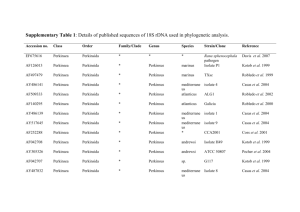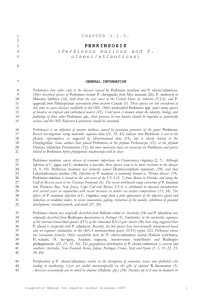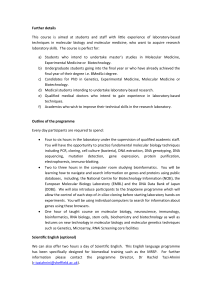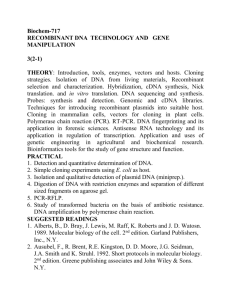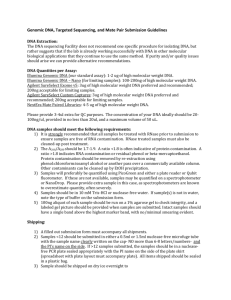prof laboratories
advertisement
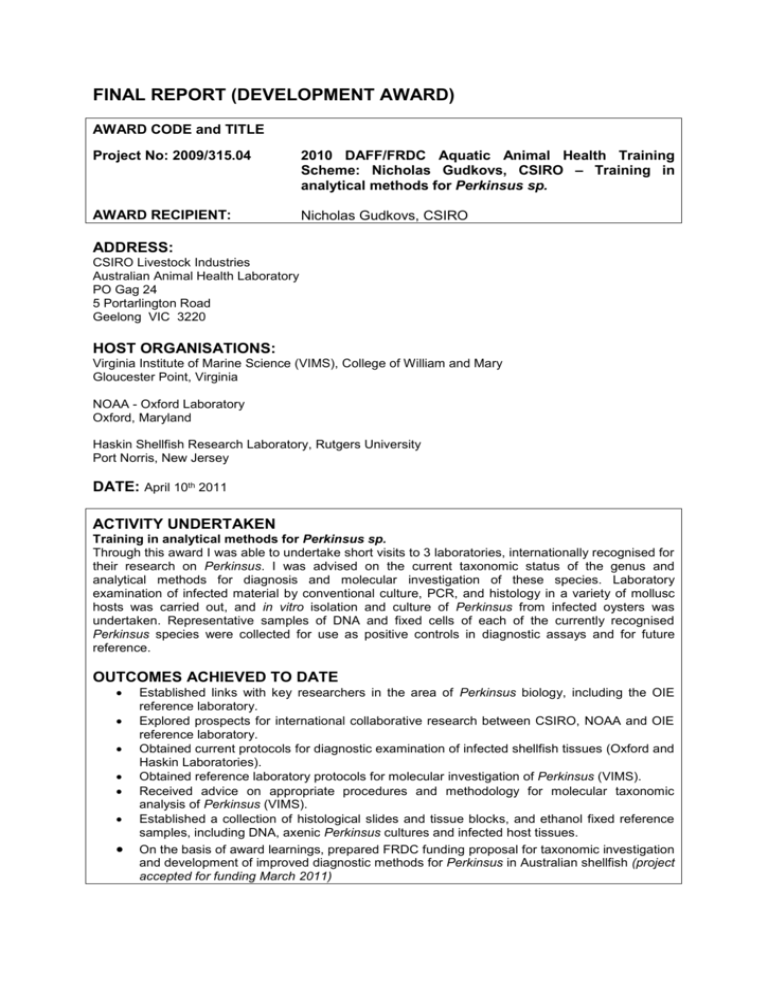
FINAL REPORT (DEVELOPMENT AWARD) AWARD CODE and TITLE Project No: 2009/315.04 2010 DAFF/FRDC Aquatic Animal Health Training Scheme: Nicholas Gudkovs, CSIRO – Training in analytical methods for Perkinsus sp. AWARD RECIPIENT: Nicholas Gudkovs, CSIRO ADDRESS: CSIRO Livestock Industries Australian Animal Health Laboratory PO Gag 24 5 Portarlington Road Geelong VIC 3220 HOST ORGANISATIONS: Virginia Institute of Marine Science (VIMS), College of William and Mary Gloucester Point, Virginia NOAA - Oxford Laboratory Oxford, Maryland Haskin Shellfish Research Laboratory, Rutgers University Port Norris, New Jersey DATE: April 10th 2011 ACTIVITY UNDERTAKEN Training in analytical methods for Perkinsus sp. Through this award I was able to undertake short visits to 3 laboratories, internationally recognised for their research on Perkinsus. I was advised on the current taxonomic status of the genus and analytical methods for diagnosis and molecular investigation of these species. Laboratory examination of infected material by conventional culture, PCR, and histology in a variety of mollusc hosts was carried out, and in vitro isolation and culture of Perkinsus from infected oysters was undertaken. Representative samples of DNA and fixed cells of each of the currently recognised Perkinsus species were collected for use as positive controls in diagnostic assays and for future reference. OUTCOMES ACHIEVED TO DATE Established links with key researchers in the area of Perkinsus biology, including the OIE reference laboratory. Explored prospects for international collaborative research between CSIRO, NOAA and OIE reference laboratory. Obtained current protocols for diagnostic examination of infected shellfish tissues (Oxford and Haskin Laboratories). Obtained reference laboratory protocols for molecular investigation of Perkinsus (VIMS). Received advice on appropriate procedures and methodology for molecular taxonomic analysis of Perkinsus (VIMS). Established a collection of histological slides and tissue blocks, and ethanol fixed reference samples, including DNA, axenic Perkinsus cultures and infected host tissues. On the basis of award learnings, prepared FRDC funding proposal for taxonomic investigation and development of improved diagnostic methods for Perkinsus in Australian shellfish (project accepted for funding March 2011) Acknowledgments I would like to acknowledge and thank Prof. Kimberly Reece, Prof. Ryan Carnegie, Dr. Corrine Audemard, Dr. Gail Scott and Ms. Alanna McIntyre at Virginia Institute of Marine Science. Dr. Chris Dungan and Mrs. Lee Hamilton at the Oxford Laboratory, Maryland and Prof: David Bushek, Rutgers University, for their generosity in providing their valuable time and expertise in helping me unravel some of the difficulties of working with Perkinsus spp. and for providing laboratory procedures and reference samples of preserved parasites and DNA. Background Improved diagnostic methods for both enzootic and exotic pathogens of aquatic animals have been identified as Key Research Areas in the 2005-08 FRDC AAHS R&D plan. Perkinsus olseni is currently listed by the OIE and appears on Australia’s National List of Reportable Diseases of Aquatic Animals, and is therefore a priority for diagnostic test development. Currently Australia has limited expertise in the genetic analysis of protozoan parasites of molluscs. The training obtained through this project and the interaction with recognised international experts active in the area of genomics of these protozoans, will have direct benefit for research into the diversity of these parasites and for the development of improved molecular diagnostic methods. Need Perkinsus is a major pathogen of molluscs throughout the world and Perkinsus olseni remains a significant pathogen of Australian abalone. As we only have a limited understanding of the genetic homogeneity of this and other Perkinsus spp. in Australia, the specificity of conventional cultural methods of diagnosis has been questioned. With the recent observation of Perkinsus DNA sequence, perhaps representing new species, confidence in the reliability of molecular methods, such as PCR and qPCR (real-time), has also been questioned. In order to address this problem a targeted genetic study of Perkinsus in Australia is required. Given the extensive experience with these parasites overseas and the limited expertise in this area in Australia, the training visits were to provide rapid and direct insight into the current state of knowledge of Perkinsus taxonomy and genetics and of how best to undertake such analysis. In addition, access to a range of reference material and the opportunity to establish collaborative links with institutes currently undertaking similar work elsewhere would provide the best possible support for undertaking this work. Objectives To obtain training in methods for genetic analysis of Perkinsus. Obtain training in current methods used for molecular differentiation of Perkinsus spp.. Methods The visits centred on 3 laboratories with a strong record of research in the area of molluscan disease, particularly Perkinsus. The Virginia Institute of Marine Science (VIMS) has a large research based study program and is the main campus for post-graduate marine studies at the College of William and Mary. VIMS is also host to the OIE reference centre for Perkinsus, where activities centre on histopathology and molecular analysis/characterisation of Perkinsus. The core staff includes Prof. Kimberly Reece (head), Prof. Ryan Carnegie (research professor), Dr. Corrine Audemard (post-doctoral fellow) and Dr. Gail Scott (laboratory manager). While at VIMS my primary goal was to determine the best strategy of investigation for mollusc populations infected with Perkinsus and to develop an understanding of how to undertake analyses of populations where multiple Perkinsus species may be present. My primary interaction was with Professor Reece, however in the course of my visit I had detailed discussions with all the people mentioned above, who generously provided a detailed insight into how to undertake both routine analysis of Perkinsus samples and the characterisation of new protozoan species. The majority of time was spent looking at molecular methods of analysis and the underlying basis of their use and design, including and the best current molecular assays for Perkinsus genus and species identification. The usefulness of various DNA regions including the large (LSU) and small (SSU) ribosomal sub-units and the Internal Transcribed Spacer were discussed with respect to their role in differentiating and characterising new species. Under the guidance of Dr. Reece, I examined DNA sequence alignments from the library of Perkinsus data maintained at VIMS, in order to see how to best find regions which may be useful targets for test development for new species. Good quality molecular analysis software plays a large part in such analysis and some recommendations were made (Geneious software). In the laboratory, I investigated procedures for nucleic acid isolation from molluscs used at VIMS and undertook basic PCR screening of Perkinsus samples. A range of these samples were later fixed in ethanol and retained as a source of reference material for future testing in Australia. From VIMS I travelled to see Dr. Chris Dungan at the Oxford Laboratory in Maryland. VIMS has a close collaboration with the NOAA Oxford Laboratory where Perkinsus species are cultured in vitro. This is different to Ray’s culture method where Perkinsus hypnospores expand in size and are differentially stained with Lugol’s Iodine. In vitro culture of Perkinsus is carried out using specialised media and modified cell culture techniques to produce replicating axenic cultures of Perkinsus cells. These cultures are useful, as they provide a virtually limitless source of Perkinsus cells without contaminating host tissues. Genomic DNA derived from these cultures can be amplified and analysed without the confounding affects of host DNA which carries some of the same genes useful in the genetic characterisation of Perkinsus. DNA from these cultures therefore does not need to be cloned before analysis. All media, methods and procedures were made available and I was able to review the procedure in detail, dissect infected oysters and undertake preparation of primary Perkinsus cultures from infected oysters. Parallel cultures had been set up 1 and 3 days prior, so I was also able to observe and follow cell differentiation and development in my own preparations and as they would appear in the later stages normal course of the procedure. The Oxford Laboratory has an extensive collection of histopathological material representing all currently known species of Perkinsus in a variety of hosts. It was therefore possible to also review and examine many of the developmental stages of Perkinsus histologically in a variety of hosts. Apart from providing practical training in the propagation of Perkinsus, Dr. Dungan kindly donated a large number of ethanol fixed cultured Perkinsus cells and a range of histological blocks and slides. The Haskin Shellfish Research Laboratory in New Jersey maintains an active research program on the ecology of Perkinsus. Prof. David Bushek provided a detailed overview of the origins of Perkinsus and current procedures for diagnosis and detection used at the Haskin Laboratories. In order to gain experience with recognising Perkinsus hypnospores in thioglycolate medium (RFTM), I was able to examine a large number of Perkinsus thioglycolate cultures prepared as part of their environmental monitoring program. This was particularly interesting and useful as a range of infection intensities and hypnospores morphologies, representing a spectrum of presentations that might be encountered, was observed within a short period. At the same time, a range of standardised Perkinsus suspensions were prepared by haemocytometer and used to establish experimental infections in oysters. Prof. Bushek also kindly donated histological blocks from their collection. Results/Discussion This DAFF/FRDC development award provided a unique opportunity to obtain training in current methods of Perkinsus diagnosis and research from leading researchers in the field. While the training undertaken specifically related to the study of protozoans and Perkinsus in particular, some aspects of the training will also have wider application to other areas of research in the future. At the same time links for future international collaborative research were also established. Detailed protocols for PCR/DNA based sequencing identification of Perkinsus as implemented by the OIE reference laboratory were obtained and the general strategy for their application to new or previously unidentified Perkinsus species was examined in detail. The appropriate types of DNA sequence analysis and requirements and criteria for recognising new species were also studied. The best strategies for cloning and multiple sequence analysis of field samples was reviewed within the context of identifying previously recognised Perkinsus species and detecting and differentiating new species. The training and experience of establishing axenic Perkinsus cultures (Perkinsus marinus from Crassostrea virginica) was particularly valuable and will have specific application to establishing cultures of Australian species. Procedures for cryopreservation, storage and resuscitation of cultures were also reviewed. The molecular analysis of pure cultures not only provides large quantities of DNA but also avoids some of the additional complexity encountered when analysing eukaryote DNA from a mixture of both host and parasite DNA. The opportunity to handle and observe developing cultures provided valuable insight into the procedures and equipment required to undertake this work. This was particularly true of the setup of microscope illumination and optics. Based on the information gained through this training award an FRDC funding application on Perkinsus was submitted in late 2010. This application was approved for funding in February 2011: Project 2011/004 Aquatic Animal Health Subprogram: Development of improved molecular diagnostics for Perkinsus olseni in Australian molluscs. Benefits and Adoption Perkinsus is a major pathogen of molluscs and the cause of serious disease in both oysters and abalone. In Australia Perkinsus has been a serious problem in wild abalone, but other non-commercial species may also be affected. It is anticipated that the primary beneficiaries of this award will be the abalone industry. The development and implementation of reliable and sensitive molecular diagnostic tests for Perkinsus will provide both federal and state testing laboratories with the ability to apply rapid and reliable detection of Perkinsus in a variety of samples. These tests will have direct application for both the diagnosis and confirmation of disease and also the screening of animals prior to selection and movement of stocks. Further Development The training and experience gained through this award have direct application to the newly funded FRDC project 2011/004. The results of this project will be disseminated through the preparation of scientific publications, standard diagnostic methods and the FRDC Australian Scientific Conference on Aquatic Animal Health.
